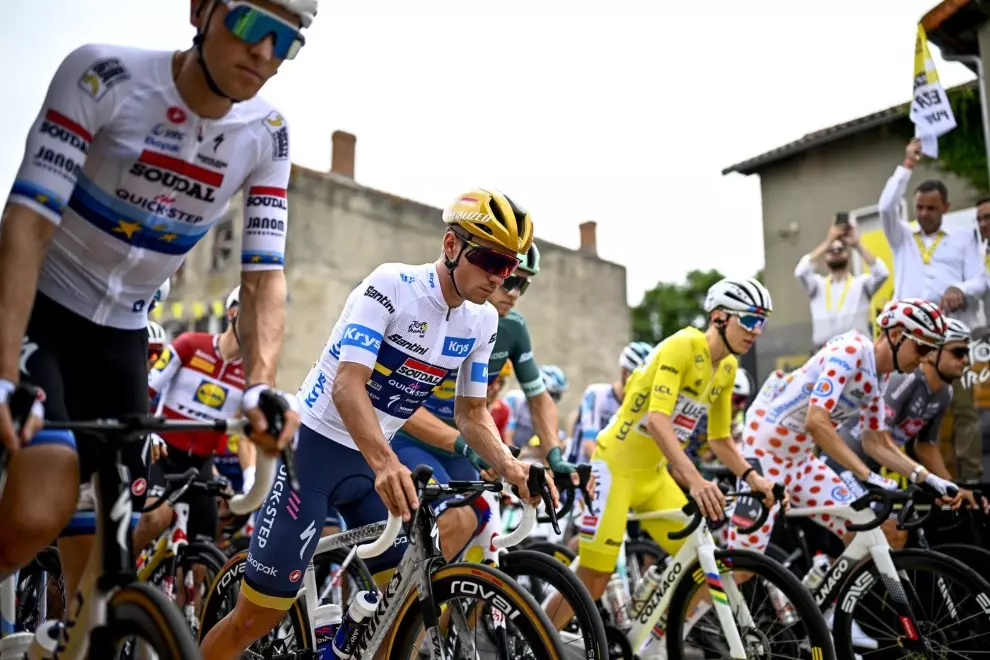First up, lets take a look at ‘Sprint Trains’ or the ‘lead outs’ for the fast men like Mark Cavendish, Caleb Ewan and Marcel Kittel, to name but a few.
The rise of Sprint trains
The emergence of sprint trains as a dominant force in the Tour de France can be traced back to the early 2000s, to about the time I was riding as a pro. Before this period, sprinters relied primarily on individual talent, one other key rider that acted in support and tactical prowess (or road craft) to position themselves for the final, often chaotic sprint. However, as teams recognised the advantage of organising their riders to create a lead-out train, the dynamics of sprint finishes shifted dramatically. Think of Mario Cipollini and his team Saeco lead out, one of the first of its kind. I remember a few times looking on in awe as I watched them in action from my position a bit further back in the bunch.
To explain further, ’Sprint trains’ or ‘lead outs’ involve a series of riders working together to deliver their designated sprinter to the front of the peloton at super high speed, enabling them to launch their sprint as effectively as possible. This hyper-specific team work is aimed to maximise the sprinter’s chances of victory while minimising the impact of things such as wind resistance and the fight to get into position. One of the best modern day examples of this would be Quick Step leading out Mark Cavendish to four record-equalling wins at the 2021 Tour de France with Michael Morkov the final, key lead out rider.
The changing GC landscape
While the sprint trains evolved, the general classification battle experienced its own transformation. Traditionally, individual GC contenders would rely on their team’s support in the mountains to protect their position and potentially gain time on rivals. However, over the past 20 years, teams have adopted a more specialised approach, building squads tailored to the specific strengths of their GC leaders. Think Team Sky in the service of Chris Froome and Bradley Wiggins and Jumbo Visma’s all conquering squad that saw Jonas Vingegaard win the 2023 Tour. Domestiques are now often deluxe helpers with race-winning abilities themselves. Geraint Thomas helping Chris Froome and Wout van Aert assisting Jonas Vingegaard are two of the best examples.

Today, GC teams have become far more structured and cohesive units, with pure climbers and domestiques working together to shepherd their leader through the mountains, over the cobbles as well as shielding them from crosswinds. This shift has intensified competition among teams, as the focus is not just on individual performances but on the collective strength of the entire team. The increased emphasis on teamwork has made the Tour de France a more strategic and tactical battle, where every rider’s role is vital. Who can forget stage 11 of the 2023 Tour, when Jumbo Visma attacked race leader Tadej Pogačar with Primož Roglič, Wout van Aert and Jonas Vingegaard gradually wearing down the yellow jersey with multiple moves off the front. This day arguably won the race for the Norwegian, and Pogačar never fully recovering from this tactical onslaught.
Team size impact
Another significant change that has affected team dynamics in the Tour is the reduction in team sizes. Until 2018, teams consisted of nine riders, but beginning in 2019, the UCI (Union Cycliste Internationale) reduced the maximum team size to eight. This reduction has forced teams to make strategic decisions regarding the allocation of resources and the selection of riders with multiple capabilities.
With one fewer rider at their disposal, teams have had to become more aware and efficient in their strategies, yet, at the same time, this has also seen teams become more creative and unorthodox, which has made for some very exciting racing. The loss of a single rider can have a significant impact, especially in supporting GC contenders. Consequently, teams have had to adapt by ensuring that each rider possesses the necessary skill set to contribute effectively in multiple race situations.
Resource allocation and tactics
The reduction in team size has also led to changes in resource allocation and tactical choices. With fewer riders to support their leaders, teams must prioritise which stages to target, selecting the most suitable terrain for their GC ambitions. The limited number of riders also means that teams need to be more strategic in their use of domestiques, ensuring they are available at critical moments of the race. The Ineos Grenadiers, for example, often rotate riders to keep them fresh for key stages when they’ll need to make an impact.
As the Tour de France continues to evolve, it remains a captivating showcase of teamwork, strategy, and individual brilliance that entertains, inspires and enthrals us all. The dynamic changes we’ve seen over the past couple of decades highlight our beautiful sport’s continuous pursuit of innovation and adaptation, pushing teams to redefine the boundaries of what is possible in the world’s greatest cycling race. I can’t wait to see what the 2023 edition brings!




